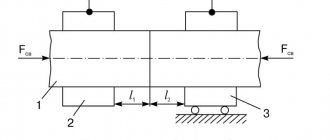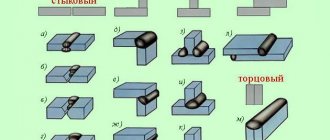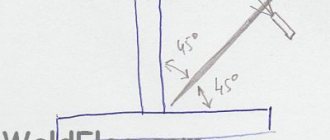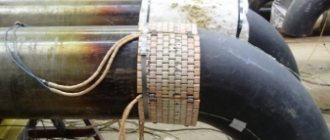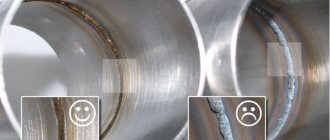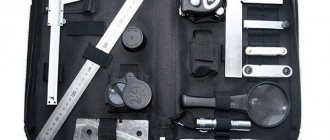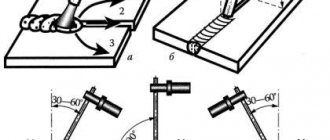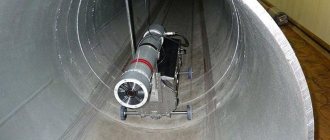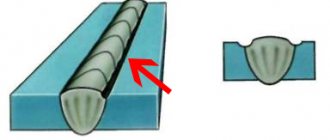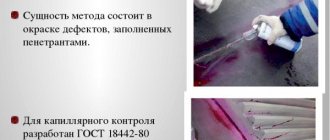Home / Welding technique
Back
Reading time: 3 min
0
479
Welding joints are a very common welding technology; it is used almost everywhere, since metal structures are often made up of elements that need to be connected.
For this purpose, many types of welding were invented using different equipment such as automatic, semi-automatic, manual welding, as well as many imported and domestic consumables.
This method is simple and does not require large expenditures, but it demonstrates good results.
Of course, it is difficult to conform to a standard, since each metal is individual, has its own thickness and properties, and the quality of the connection depends on this.
To work with welding, of course, you need to have basic knowledge of physics and chemistry; first of all, this will affect your safety, and in a business like welding this is quite important.
But as we have already said, each metal is special in its chemical and physical properties. For this purpose, a method was developed to individually calculate the quality of the connection for different cases.
Such parameters will orient you to the level of quality of the seam that is in front of you.
- General information
- How to determine the strength of a weld? Seams at the joints
- Seams on the corner
General information
Welding provides the highest quality and unbreakable connections, as mentioned above.
The essence of this process is this: molecular bonding occurs when we heat two metals to such an extent that they begin to melt in the places where we need to connect them. We can make them pliable using mechanical force.
Everything has its drawbacks, for example the welding seams are not ideal either. Of course, with certain methods they turn out almost ideal if the welding is in the hands of a professional, but with some welding methods they are completely imperfect.
Sometimes this is due to rapid and uneven heating and cooling and may leave some stress in the parts.
There may be other problems during welding, such as sagging, unwelded areas of the seam, or cracks.
At the same time, due to inexperience, it may not even be possible to weld two metals that, due to their chemistry, cannot be combined, but for this you need to have some experience.
Of course, all these shortcomings significantly spoil the quality of the work and sometimes make it completely useless, and then it’s a pity for the wasted time and consumables. But there are still ways to effectively combat this.
In order for your connections to be perfect, you need to calculate everything in advance even when the project is being drawn up.
It is very important not to make mistakes at this stage, you will pay dearly for them later, you will have to redo all the work again, and you can still ruin the metal and make it no longer suitable for welding.
So study well the properties of the materials that you will use, whether they will be firmly connected, withstand loads, to what temperatures it is best to heat and what type of welding to use when working with a certain type of metal.
Such design work is useful in many ways, if you calculate all this in advance, then first of all you will be guided by the amount of necessary consumables, and you will even be able to calculate the approximate work time, and this is very useful in production or when you have a hired employee who works 8 ocloc'k.
Types and features of welds
In welding, as in any other technological process, not only the final result is important, but also all those nuances on which the final quality of the work depends. In our case, the equivalent of quality is the welding seam, since the strength (and therefore durability) of the metal structure directly depends on it.
For welding, a master needs not only high-quality components and equipment, but also invaluable experience. To accumulate it, you need to constantly study and practice. You will have to take care of the practice yourself, but we will help you with the theory. In this article we will describe in detail what types of welds exist and what features need to be taken into account in order to complete the job efficiently.
articles
general information
Before you find out what types of welded joints and seams there are, you need to define the concept of the properties of a welded joint. Properties are, in essence, the characteristics of the seam, on which its quality depends. Properties include strength, toughness, elongation and contraction. But what determines the properties of a welded joint? The properties of a weld depend on the metal, welding method, components and many indirect factors (for example, welder fatigue).
It is also important to know what load the weld can withstand. There is a lot of controversy about this on the Internet. Every craftsman believes that he knows how long a weld seam can withstand. All we will say is that there is no single answer to this question. For each type of metal this is a separate value, since different types of seams have their own tensile strength.
Types of seams
Here are the main types of welded joints and seams:
- butt
- overlap
- angular
- tee
In this article we examined in detail each type of welded joint.
PECULIARITIES
Seams have their own additional features that you need to know. First of all, this is the form of connection. It can be protruding, sunken or flat. The choice of form depends on the specific tasks to be performed.
For example, a protruding (or simply convex) seam is used when welding metal structures that are subject to increased load requirements. Sunken (or concave) seams can easily withstand various types of dynamic loads. But in most cases you will find flat seams, since their characteristics are the most versatile and can be applied to most types of work.
How to determine the strength of a weld?
Of course, making such a calculation is not at all easy, you need to use several formulas and spend an hour of your time, but in order to know that your welds will have a high strength coefficient, you still need to take into account how the metal is located, its shape, dimensions, features.
There are many methods of welding, using a variety of equipment and consumables, of course, each type of welding gives a different result, some were invented for working in difficult areas, and some are suitable for beginners, but in our time the following types of welding remain the most popular:
- Electric welding, it also has two subtypes, like arc welding and contact welding;
- gas welding.
We also cannot skip welding manually and using a semi-automatic machine, but these are no longer types, but methods of operation and a type of equipment.
The type of welding that we choose for certain jobs depends directly on how the parts that need to be welded are placed.
It also often depends on the type of metal that we will weld; for non-ferrous metals, some types of welding are effective, and for ferrous metals, others are effective, and there are also a huge number of other properties and factors.
The most common are tee and butt, corner and overlapping corners. For each type of seam, their quality is calculated separately since they have completely different quality characteristics.
Seams at the joints
In order for us to calculate the strength coefficient of a seam, we must take several parameters starting from the nominal cross-section, not forgetting that we do not need to take into account the number by how much the seam will increase.
The calculation begins with information about the resistance of metals, which appears in solid beams.
Later, the shear normal stress will begin to affect your seam, for the equivalent stress in such a situation, use the formula below.
We describe the situation in which a strong connection is like this: E ≤ [']P.
To find information on this parameter, check out the table below.
Seams on the corner
If you have a job with a fillet weld, then most likely there will be a cross section. The edges relate circle to friend as 1:1. The leg of the weld seam, or as it is written on diagrams and in textbooks “K”, remember this designation.
Often the seams are subject to deformation and cracks in the area of the dangerous section, simply where the thin sections are, these are the most fragile zones that pass through the bisector of the corner. In cases of such a cross-section, the size can be calculated using the formula *K.
The length of the seam is also one of the main indicators. It is he who can indicate what kind of load a given connection can withstand.
Calculation of the length of welds based on the weight of the metal of the structure or surfacing
The productivity of welded production depends on the quality of design documentation and labor organization. It all starts with determining the type of parts and assigning weld parameters that determine strength: length, volume of deposited metal. Each enterprise is unique, so standard data is not enough; it must be calculated.
An important parameter for butt alloys is the cross-section of the welding zone. Its dimensions and quality must be such that they are capable of withstanding the planned bending and tensile loads. Given the variety of welding methods and material protection, it is advisable to carry out calculations for each junction. This will not only improve quality, but will also reduce costs through more rational use of consumables.
Standards for electrode consumption when welding sheet metal
Butt welding is the connection of two elements located in the same plane and adjacent to each other at their ends. Work can be carried out manually, semi-automatically or automatically using electricity or gas, with or without gas protection. The seam can be short (up to 25 cm), medium (25-100 cm), long (more than 100 cm), single-layer or multi-layer, single- or double-sided. Depending on their location in space, joints can be horizontal, semi-vertical, vertical, or ceiling.
Based on operating conditions, soldering can be bonding or designed for certain loads. When calculating the consumption rate of electrodes and other additives when welding sheet metal, it is necessary to take into account all these features.
Filler materials and their features are listed in GOST 2246-70. 77 types of steel wire with different chemical compositions are produced. It can be used not only for welding and surfacing, but also for the manufacture of electrodes. A special type is flux-cored wire. This is a tube filled with charge. A wire additive for aluminum, titanium, and copper is also available. Electrodes are supplied melting and non-melting (to support combustion).
Example analysis
When our welding takes place in manual, semi-automatic or automatic mode, the indicator will be equal to 0.7. If everything is calculated correctly, then the seam has the shape of an isosceles triangle.
If you cook using the most common semi-automatic machine, but you did everything robotically in several stages, then it will be equal to 0.8.
In the same situation, but when using an automatic machine, this indicator will be 0.9, and if our automatic machine has single-wire welding, then the indicator will still be 1.1.
It is necessary to take into account PLEASE NOTE! When calculating the strength of a weld at an angle, it is necessary to calculate the tangential stresses.
But in order to maintain this condition, you need to know this is the total shear stress. In order to find out this indicator, you need to determine the point at which the most voltage drops.
What parameters are used in the calculation
When calculating the strength of welded joints, a number of indicators are required.
Knowing them allows you to make calculations with the smallest error.
The following main parameters are taken into account:
- Ry is the resistance of the product material taking into account the yield strength; this is a constant value for each metal;
- Ru is the resistance of the material in accordance with the tensile strength; standard tabular indicator;
- Rwy - resistance taking into account the yield strength;
- N is the maximum permissible load that the clutch can withstand;
- t is the minimum thickness of the parts to be connected;
- lw is the maximum length of the welded joint; when calculating it, it is reduced by 2t;
- gс is the coefficient of conditions that prevail in the workplace; a standardized parameter, present in generally accepted tables, in particular, in manuals for welders.
The process of tension and compression of metal is calculated using the formula:
.
If during the manufacture of a product parts from different metals are welded, then the formulas use Ry and Ru for the material with the lowest strength. Proceed similarly when enabling parameters in the calculation of a shear seam.
When calculating strength, a number of indicators are required.
In addition to the above numerical indicators, the reliability of the connection is affected by:
- quality of the product material;
- correctly selected consumables (additives, electrodes);
- welding mode, including polarity and current strength;
- careful processing of workpieces - there should be no deformations or foreign inclusions on the edges of the joints;
- compliance of the welding machine with the required welding technology and power.
Such characteristics must be taken into account; the accuracy of calculating the clutch quality depends on each of them.
Classification of metal structures
Different elements are distinguished according to a number of characteristics. They differ in characteristics and application, which means they require a separate (non-standard) project and individual calculation. Let's take a closer look at some of them.
Types of seams
There are:
- Overlap. One plane partially covers the other, and significant compaction occurs. This looks unaesthetic, but adds strength, since welding occurs in two places.
- Joint. Two planes are soldered into one. The most frequent method.
- Corner. This method is used when a curved rather than straight structure is required. A preliminary calculation is required to determine the degree of the angle.
- Connection-brand. It looks like the letter “T”, since the end of one part is applied to the area of the second.
- End method. The two elements are placed side by side. In this case, the seam is obtained not across, but along the product.
In order not to increase the strength of the welding current, you should first do the cutting - this is the procedure for creating bevels. They can be unilateral or bilateral.
Classification of welded structures by application
There are:
- aviation - for the creation of aircraft and other air transport;
- marine - used in the design of ships;
- wagon - created for the installation of railway cars and locomotives;
- mechanical engineering – used as elements of heavy equipment and machine tools;
- automotive - intended for the body and interior of a car;
- construction - for the construction of buildings, and others.
Classification by functions and characteristics of metal structures
In the process of creating large structures, smaller elements are taken into account. When creating a project, it is important to take into account the features of each part, as this affects the calculation of the strength of the weld, for example, there are:
- Beams. These are metal ceilings and other parts that receive transverse bending. If possible, they should be welded along, and not across, in order to strengthen the finished metal profile or sheet. You can also apply them not only parallel, but also strengthen them lengthwise, also using the welding joining method. The result is a durable lattice.
- Columns. They are installed perpendicular to the floor. It is important to test them for compression, while the previous type worked for tension.
- Lattice connections. They are welded at the nodes. This type is often used in the process of reinforcing foundations and buildings in general.
- Structures whose operation requires resisting pressure from the inside or outside. Usually these are containers or pipes containing a liquid or gaseous substance. Used in the creation of engineering systems.
- Metal structures for vehicles. Their main characteristics are aesthetics, low weight and rigidity. They are used to create ribs near the car body.
Conditions for a high-quality vertical seam
Almost all novice specialists are not familiar with the basic conditions for obtaining a high-quality vertical seam. In addition, it must be characterized by high strength, be made with high quality and have an aesthetic appearance.
There are several main mistakes that are made when carrying out such work:
- At the time of arson, the rod must be in a perpendicular state. If there is an angle, the arc may be unstable.
- The shorter the arc length, the faster the material crystallizes. This reduces the risk of leaks. However, many do not follow this recommendation, since a small arc reduces the performance indicator.
- The rod is tilted to reduce the likelihood of smudges, but maintaining an acute angle is quite difficult.
- If a leak appears, it is recommended to increase the current and the width of the seam. Due to this, the process of crystallization of the substance can be significantly accelerated.
To obtain a compound with a high quality index, you need to pay attention to the preparatory stage. An example is the removal of dust and dirt, paint and oil residues, and rust. In some cases, spot welding is carried out, due to which the risk of drips is reduced several times.
High-quality vertical seam
In conclusion, we note that the quality of the weld depends on a fairly large number of parameters. An example is the skill of the welder or the characteristics of the materials being joined. Depending on some of the above parameters, the most suitable technology is selected.
Article rating:
What load can a weld seam withstand? Link to main publication
Related publications
- Car weld sealant
General information.
Typically, the Greek letter φ is used to denote the strength coefficient of welded joints. The website uses the letter f for designation in calculations.
The design strength factor φ is a relative value used in formulas to determine the wall thickness of the design part and takes into account weakening by holes and welded joints.
Strength coefficients are determined during the strength calculation process according to the selected calculation method. In different methods, the classification by strength coefficient can be different and have its own nuances.

